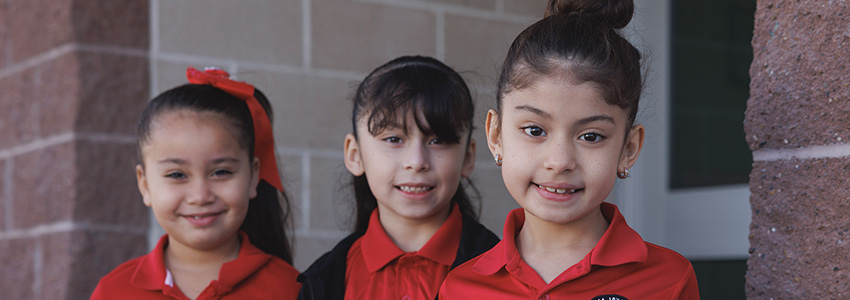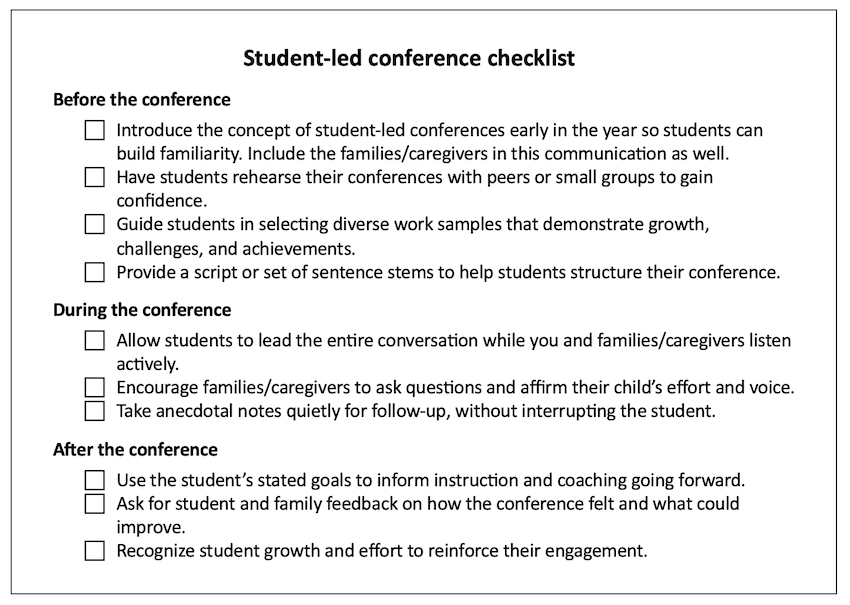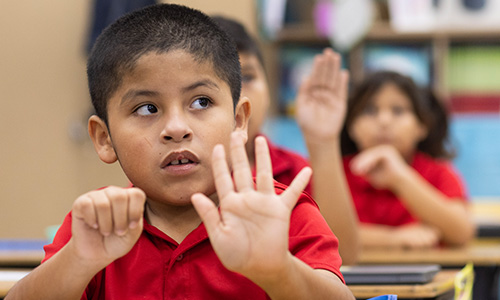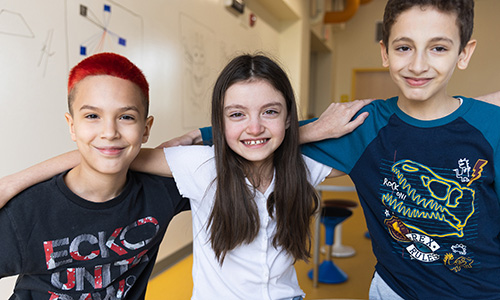 Student-led conferences are a powerful tool for fostering student agency, accountability, and meaningful family engagement. Allowing students the opportunity to have choice and utilizing conferences to reflect can also help you build meaningful relationships. The following tips can help you ensure the time is well spent.
Student-led conferences are a powerful tool for fostering student agency, accountability, and meaningful family engagement. Allowing students the opportunity to have choice and utilizing conferences to reflect can also help you build meaningful relationships. The following tips can help you ensure the time is well spent.
1. Prepare students ahead of the conference
Preparation is the key to success with student-led conferences. Whether you’re dipping your toe into the water or diving in headfirst, a game plan is a must.
You have the exciting job of deciding what conferences will look like in your classroom. You get to create a system that will work for you and your students. Asking the following questions ahead of time can help:
- How often will student-led conferences take place? Will they be solely during caregiver–teacher conferences? Will they align with various learning projects students are working on?
- How will students select work samples to discuss? Will students make these decisions on their own? Will you provide guidelines?
- What reflection questions will you ask students to answer? Will they be focused on identifying strengths and challenges? Will they be aligned to goal setting? Will questions change each time you have conferences?
- How will you model and rehearse effective student-led conferences? Will students be encouraged to discuss their goals and progress with their classmates?
2. Engage families early
When planning caregiver–teacher student-led conferences, engaging caregivers in advance helps communicate what a conference will look like, what a student will be doing, how caregivers can prepare, and expectations. This can help avoid confusion and anxiety. Talking with families in advance can also facilitate scheduling, since many families may have another school-aged child or full-time work to plan around.
When families are able to gain a clearer, more personal view into their child’s learning, you’ll likely see shifts in the dynamic from teacher-driven to student-centered, which can create a more collaborative partnership. Students will also likely find it easier to talk to their families about what they are doing in class and how they are taking charge of their learning.
3. Use portfolios
I remember having to create a portfolio for my first year of teaching. Oh, boy, that was taxing. The portfolio included a lot of tabs, printed papers, and paper protectors. The thought of having my students replicate something like that has never appealed to me. That said, the experience helped me realize portfolios do not need to be fancy.
The first portfolios I used in my classroom were simply file folders each student got to decorate. I also gave my students the choice to add whatever they wanted to their portfolio. We’d briefly chat about the why behind including a specific piece in the portfolio every other week or so during small group time. This created opportunities for students to celebrate each other’s work, too.
As we continued our portfolio journey, students learned they couldn’t put something in their portfolio “just because” or “because it was cool.” They were expected to provide concrete evidence of growth and achievement as well as make a clear connection to their goals.
Allowing students to choose their own artifacts to talk about helped build ownership. I would also add an artifact or two for students to help provide a more complete picture. There are many times when students don’t realize the progress they are making; when I took the time to save a specific paper from the recycling bin and add it to a portfolio, I was able to share with students specific examples of what they did that made me proud.
Our portfolios were housed in a filing cabinet that students had access to. When I switched rooms and no longer had a filing cabinet, I used file boxes.
4. Include assessment data
Whether your school tests with MAP® Growth™ or a different interim assessment, don’t forget to make scores a part of student-led conferences. In my classroom, we’d look at overall reading scores but also drill down into performance by instructional area. Connecting these instructional areas to our daily work allowed students to see where they had strengths and where they had space to plant themselves and grow.
For guidance on discussing MAP Growth scores during conferences, I encourage you to read the following articles:
- “6 commonly used MAP Growth terms worth knowing”
- “How to use MAP Growth data to ask meaningful questions”
- “Students can own their data: 5 ways to get started”
- “What can you do with the 2025 MAP Growth norms? Turning test results into action”
- “Realistic vs. meaningful growth: Rethinking growth goals with the 2025 MAP Growth norms”
5. Set a clear agenda
A clear structure helps everyone feel prepared for a student-led conference. The following worked well in my classroom:
- Introduction
- Student presentation
- Caregiver or peer + teacher questions
- Identification of goals or next steps
- Closing
Note that students didn’t have these conversations with only me; they also learned to have these conversations with each other so they could benefit from the expertise and knowledge of their classmates; the learning that occurred when they were working together was always beyond remarkable. My students were also encouraged to have these conversations with family members. Including caregivers in student-led conferences can help kids feel more supported, which can increase engagement.
6. Use sentence stems to guide conversations
Conference conversations eventually happened organically, but early in the school year, I would make a point of providing students with sentence stems they could refer to. I would make sure the sentence stems were available on posters hung in our classroom, and students also received copies for their folder.
Below are examples of sentence stems that worked well in my classroom.
Goal-setting sentence stems
- “One of my goals this term is to…”
- “I chose this goal because I want to improve in…”
- “To reach my goal, I plan to…”
- “A small step I’ve already taken toward my goal is…”
- “One thing I will do differently next time is…”
Growth and progress sentence stems
- “I’ve grown the most in…”
- “At the beginning, I used to…, but now I…”
- “A challenge I overcame was…”
- “I’m proud of this piece of work because…”
- “This shows my progress because…”
- “Compared to last time, I can now…”
Self-awareness and reflection sentence stems
- “Something I did well was…”
- “An area I still need to work on is…”
- “I was surprised by…”
- “I learn best when I…”
- “When I struggle, I try to…”
- “One thing I’ve learned about myself as a learner is…”
Thinking and learning strategies sentence stems
- “When I didn’t understand, I…”
- “A strategy that worked well for me was…”
- “Next time, I would try to…”
- “To solve this problem, I had to…”
- “I revised this work by…”
- “I used feedback by…”
Communication with caregivers and peers sentence stems
- “I chose this piece because…”
- “This work connects to my goal because…”
- “Here’s what I’d like you to notice…”
- “Do you have any questions about this work?”
- “I’d like your feedback on…”
- “Can I tell you about how I handled this challenge?”
Next steps and looking ahead sentence stems
- “My next step will be…”
- “Something I want to try is…”
- “In the next few weeks, I want to focus on…”
- “One way you can support me is…”
- “I’m excited to learn more about…”
- “Here’s what I hope to improve next…”
7. Shift your role from presenter to facilitator
When I was growing up, students were expected to sit in their seats, work silently, turn in their homework on time, and occasionally take part in a collaborative project. There is a time and place for all those things, but days of lecturing for entire class periods are not going to meet the diverse needs of students today.
As educators, we need to be vulnerable and shift our role from presenter to facilitator at times. By shifting what our role looks like in the classroom, we give students opportunities to practice communication, organization, and leadership—skills that are vital for college, career, and life.
Student-led conferences simulate real-world scenarios like performance reviews or presentations. They create opportunities for students to be bold, be expressive, and own their struggles and successes. Quite honestly, that is what life is about: learning from our mistakes, leveraging our talents, and pushing through when things are difficult. Student-led conferences foster an empowering mindset that can serve your students well into adulthood.
8. Adapt to account for student age and developmental level
We all know that one size does not fit all. That includes goal setting and student-led conferences.
Student-led conferences can be adapted for all grade levels and learning styles. Earlier, I spoke to providing sentence stems for students. That is just one example of how my classroom had differentiated opportunities to think about reflections. For younger learners, using emojis or a color-coded system, like a stop light, can be effective. For some students of any age, behavior or attendance goals may need to be discussed before any learning goals can be brought to the table.
Finding the willingness to try something and then adjusting as you go is one of the best things you can do for yourself and your students. A willingness to step outside your comfort zone to engage students can provide opportunities for every student to shine, regardless of their academic standing. When students are empowered to talk to others about their learning journey in a way that is appropriate for their age and developmental level, they can begin to realize their learning journey doesn’t have to duplicate anyone else’s; it’s all personalized.
9. Follow up
Conferences should lead to concrete, tracked goals. Students should revisit, reflect on, and update them. This ensures a conference isn’t a one‑off but is, instead, a vital part of continuous growth.
When I would set goals with students based on specific instructional areas and project-based learning, it helped students realize that academic goals aren’t simply the culmination of grades at the end of a unit or exam. Goals can be broken into short segments that can be talked about, reflected on, and adjusted based on each individual’s learning need. This process helps students take responsibility for their learning and celebrate their achievements.
You can create a culture of growth
When we create a culture that engages students and teaches them to lead their own conferences, we are reinforcing a growth mindset. We have an important job to teach students and model what learning can look like, providing tools for them to become empowered owners of their learning journey. I encourage you to use the following checklist as you prepare for student-led conferences in your classroom.
 When we provide students ample opportunities to identify areas of strength, select opportunities for growth, and see how they can self-analyze their growth, we are cultivating a culture of growth. Mistakes and challenges become part of the learning narrative, not something to hide. And isn’t learning from our trials and allowing them to springboard us forward, rather than hold us back, what life’s all about?
When we provide students ample opportunities to identify areas of strength, select opportunities for growth, and see how they can self-analyze their growth, we are cultivating a culture of growth. Mistakes and challenges become part of the learning narrative, not something to hide. And isn’t learning from our trials and allowing them to springboard us forward, rather than hold us back, what life’s all about?





